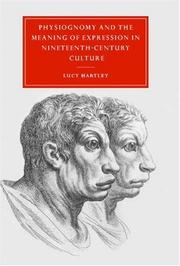| Listing 1 - 1 of 1 |
Sort by
|

ISBN: 052179272X 9780521792721 9780521022422 0521022428 Year: 2001 Publisher: Cambridge (UK) : University Press,
Abstract | Keywords | Export | Availability | Bookmark
 Loading...
Loading...Choose an application
- Reference Manager
- EndNote
- RefWorks (Direct export to RefWorks)
"In Physiognomy and the Meaning of Expression in Nineteenth-Century Culture, Lucy Hartley examines the emergence of physiognomy as a form of popular science. Physiognomy posited an understanding of the inner meaning of human character from observations of physical appearances, usually facial expressions. Taking the physiognomical teachings of Johann Caspar Lavater as a starting-point, Hartley considers the extent to which attempts to read the mind and judge character through expression can provide descriptions of human nature. She argues that the writings of Charles Bell, and the Pre-Raphaelites establish the significance of the physiognomical tradition for the study of expression whilst also preparing the ground for the rise of new doctrines for the expression of emotion by Alexander Bain and Herbert Spencer. She then demonstrates how the evolutionary explanation of expression proposed by Spencer and Charles Darwin is both the outcome of the physiognomical tradition and the reason for its dissolution."--BOOK JACKET.
Sociology of literature --- anno 1800-1899 --- portretten --- gelaatsuitdrukkingen --- emoties --- sociologie --- psychiatrie --- 19de eeuw --- gelaatsuitdrukkingen, fysionomie --- passies, emoties, affecties --- portretten. --- 19de eeuw. --- Expression --- Expression. --- Facial Expression. --- Facial expression. --- History of Medicine. --- History, 19th Century. --- Medicine --- Medicine. --- Médecine --- Physiognomonie --- Physiognomonie. --- Physiognomy --- Physiognomy. --- Physionomie. --- history of medicine. --- physiognomy. --- History --- History. --- Histoire --- Histoire. --- 1800-1899. --- United Kingdom. --- Facial Expression --- Facial expression --- History of Medicine --- History, 19th Century --- Physionomie --- history of medicine --- physiognomy --- United Kingdom
| Listing 1 - 1 of 1 |
Sort by
|

 Search
Search Feedback
Feedback About UniCat
About UniCat  Help
Help News
News